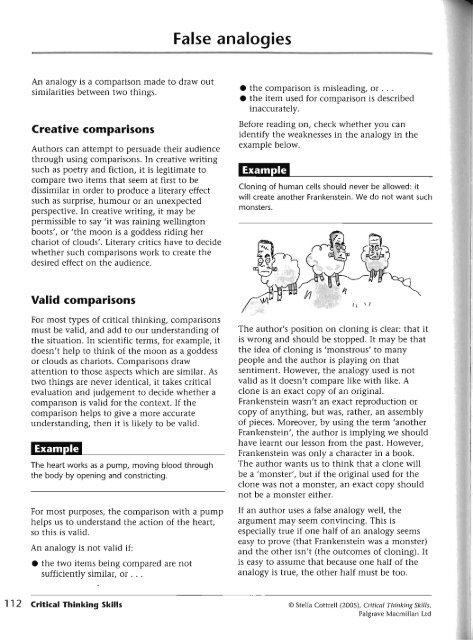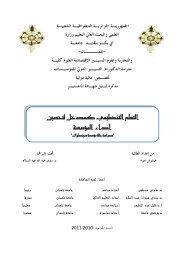Critical Thinking Skills - Developing Effective Analysis and Argument(2)
Critical Thinking Skills - Developing Effective Analysis and Argument(2)
Critical Thinking Skills - Developing Effective Analysis and Argument(2)
You also want an ePaper? Increase the reach of your titles
YUMPU automatically turns print PDFs into web optimized ePapers that Google loves.
False analogies<br />
An analogy is a comparison made to draw out<br />
similarities between two things.<br />
Creative comparisons<br />
Authors can attempt to persuade their audience<br />
through using comparisons. In creative writing<br />
such as poetry <strong>and</strong> fiction, it is legitimate to<br />
compare two items that seem at first to be<br />
dissimilar in order to produce a literary effect<br />
such as surprise, humour or an unexpected<br />
perspective. In creative writing, it may be<br />
permissible to say 'it was raining wellington<br />
bootsf, or 'the moon is a goddess riding her<br />
chariot of clouds'. Literary critics have to decide<br />
whether such comparisons work to create the<br />
desired effect on the audience.<br />
the comparison is misleading, or . . .<br />
the item used for comparison is described<br />
inaccurately.<br />
Before reading on, check whether you can<br />
identify the weaknesses in the analogy in the<br />
example below.<br />
Cloning of human cells should never be allowed: it<br />
will create another Frankenstein. We do not want such<br />
monsters.<br />
Valid comparisons<br />
For most types of critical thinking, comparisons<br />
must be valid, <strong>and</strong> add to our underst<strong>and</strong>ing of<br />
the situation. In scientific terms, for example, it<br />
doesn't help to think of the moon as a goddess<br />
or clouds as chariots. Comparisons draw<br />
attention to those aspects which are similar. As<br />
two things are never identical, it takes critical<br />
evaluation <strong>and</strong> judgement to decide whether a<br />
comparison is valid for the context. If the<br />
comparison helps to give a more accurate<br />
underst<strong>and</strong>ing, then it is likely to be valid.<br />
The heart works as a pump, moving blood through<br />
the body by opening <strong>and</strong> constricting.<br />
For most purposes, the comparison with a pump<br />
helps us to underst<strong>and</strong> the action of the heart,<br />
so this is valid.<br />
An analogy is not valid if:<br />
the two items being compared are not<br />
sufficiently similar, or . . .<br />
The author's position on cloning is clear: that it<br />
is wrong <strong>and</strong> should be stopped. It may be that<br />
the idea of cloning is 'monstrous' to many<br />
people <strong>and</strong> the author is playing on that<br />
sentiment. However, the analogy used is not<br />
valid as it doesn't compare like with like. A<br />
clone is an exact copy of an original.<br />
Frankenstein wasn't an exact reproduction or<br />
copy of anything, but was, rather, an assembly<br />
of pieces. Moreover, by using the term 'another<br />
Frankenstein', the author is implying we should<br />
have learnt our lesson from the past. However,<br />
Frankenstein was only a character in a book.<br />
The author wants us to think that a clone will<br />
be a 'monster', but if the original used for the<br />
clone was not a monster, an exact copy should<br />
not be a monster either.<br />
If an author uses a false analogy well, the<br />
argument may seem convincing. This is<br />
especially true if one half of an analogy seems<br />
easy to prove (that Frankenstein was a monster)<br />
<strong>and</strong> the other isn't (the outcomes of cloning). It<br />
is easy to assume that because one half of the<br />
analogy is true, the other half must be too.<br />
1 12 <strong>Critical</strong> <strong>Thinking</strong> <strong>Skills</strong> O Stella Cottrell (ZOOS), <strong>Critical</strong> Tlzinkiny <strong>Skills</strong>,<br />
Palgrave Macmillan Ltd



